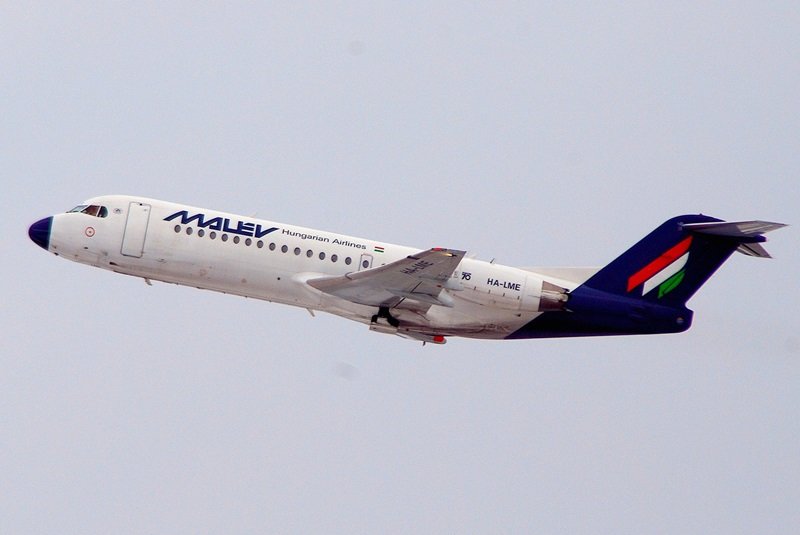
Fokker F70.
HISTORY
SPECS
Fokker F70 British Midland the first European customer for the Fokker 70.
The Fokker 70 or F70 passenger airliner is a medium-range regional jet that was produced by the Netherlands aircraft manufacturer, Fokker.
The F70 is a narrow-body twin jet with engines mounted on the rear of the fuselage and a T-tail configuration.
Driven by requests from several airlines that wanted an aircraft that catered to the market that sat between the Fokker 50 and ATR turboprop airliners and the larger Boeing 737 and MD 80 jets, Fokker decided to build on their already successful Fokker F100.
A KLM Cityhopper Fokker F70 registration PH-KZU demonstrates the use of the clam airbrake at the rear of the fuselage to aide in slowing down in the air and on the ground.
The solution Fokker came up with, was to take the Fokker 100 and reduce its fuselage length by 4.62 metres (15 feet 2 inches).
The rest of the airframe, wings and empennage, as well as modernised flight deck, was left the same as the Fokker 100. The choice of engine was the Rolls Royce Tay 620 which had been used on the earlier Fokker 100s but had been superseded by the more powerful Tay 650s. Due to its smaller size, the Tay 620 was quite adequate for the smaller Fokker 70.
The F70 also sported a tail clam air brake. Like the BAe 146 / Avro RJ this clam air brake is operated by the halves of the tail cone opening to increase drag and thereby reduce the speed of the aircraft, in-flight and on landing. This feature enabled the F70 to adhere to the 5.5% glide slope required for landing at London City Airport.
Both the Fokker 100 and Fokker 70 are modernised derivatives of the Fokker F28 Fellowship which was Fokker's first jet airliner.
SPECIFICATIONS
Fokker F70 Specs Table
| Type | Fokker 70 |
|---|---|
| First Flight | 04 April 1993 |
| Crew | Two |
| Passengers | 1 Class-85 (Seat pitch 76cm(30in)), 1 Class-79 (Seat pitch 81cm(32in)), 2 Class-72 (Seat pitch 91cm(36in)) and (Seat pitch 81cm(32in)) |
| Cabin Width(Internal) | 3.10 metres (10 feet 2 inches) |
| Cabin Height(Internal) | 2.01 metres (6 feet 7 inches) |
| Width Fuselage | 3.30 metres (10 feet 10 inches) |
| Aircraft Length | 30.91 metres(101 feet 5 inches) |
| Tail Height | 8.50 metres (27 feet 11 inches) |
| Main Wing Span | 28.08 metres (92 feet 2 inches) |
| Main Wing Area | 93.5 metres2 (1,0062) |
| Empty Weight | 22,673 kg (49,985 lb) |
| MTOW | 39,915 kg (87,998 lb) |
| Engines x 2 | Rolls-Royce Tay Mk 620 |
| Engine Thrust x 2 | 61.6 kN (13,850 lbf) |
| Speed (Max Cruise) | Mach 0.77, 456kn, 525mph, 845kph |
| Service Ceiling | 35,000 feet (11,000 metres) |
| Range Fully Laden | 3,410km, 1,841nm, 2,119mi |
History.
Development of the Fokker 70 started in November 1992, with the first flight taking place on the 04 April 1993 from Woensdrecht in the southern Netherlands and lasted 3 hours.
Following the test flight, the single F70 prototype went to Granada in Spain where it conducted all the necessary testing to gain certification which was granted on 14 October 1994.
The testing was of course less rigorous as the airframe was largely unchanged from the F100. The first production aircraft flew in July 1994.
Vietnam Airlines Fokker 70.
At the Paris Air Show in June 1993, Fokker announced that the first customer for the F70 would be Sempati Air of Indonesia, an airline that since has closed its doors.
This was certainly to be the first commercial airline customer.
The first to take delivery of the F70, however, was the Ford Motor Company. This delivery in October 1994 was an F70 fitted out in an executive jet configuration. The first commercial delivery took place in March 1995 and was to the aforementioned Sempati Air.
The first European Airline to place an order was British Midland International which took a long-term lease on 5 aircraft.
MALEV Fokker 70 registration HA-LME at Zurich (ZRH) 27JAN2007.
Fokker was keen to break into the North American market, and they had some moderate success with the Fokker 100 when USAir and American Airlines placed reasonably large orders for that type. The two airlines later merged, which no doubt had nothing to do with the Fokker 100.
Did the same market niche exist in the U.S.? Maybe not.
Whilst the F70 was certified to carry up to 80 passengers in the rest of the world, in the U.S. the F.A.A. certified the aircraft to carry a maximum of 70 passengers. The first and only carriers to order the Fokker 70 in the U.S. was Mesa Airlines subsidiary Desert Sun Airlines. The two aircraft ordered in December 1993 were operated by America West Express.
Fokker, to sweeten the deal for North American carriers, agreed to a clause in the deal that gave the carriers the right to return the aircraft to Fokker within 18 months of delivery. The two Mesa Airlines F70s were returned to Europe in 1997. These were the only two that ever operated in North America.
Alliance Fokker F70 registration VH-JFB taxing in Brisbane(BNE).
Fokker built 47 F70s plus the one prototype model between 1992 and 1997. The main customers for the type were;
Alliance Airlines - Brisbane, Australia.
Air Niugini - Port Moresby, Papua New Guinea.
KLM Cityhopper - Haarlemmermeer, Netherlands.
Austrian Airlines - Schwechat, Austria.
After several years of sustaining losses and even a merger, the Fokker company went bankrupt in 1996. There were various plans to try and restart it, but Anthony Fokker's legacy finally ran its course after 84 years.
Would the F70 have become more successful had Fokker stayed solvent? We'll never know.
Austrian Airlines Fokker 70 registration OE-LFQ.









